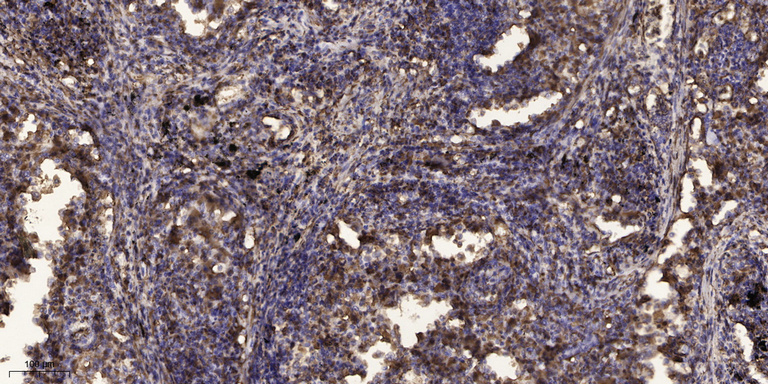PTF1A rabbit pAb
- Catalog No.:YT7416
- Applications:WB;IHC
- Reactivity:Human;Mouse;Rat
- Target:
- PTF1A
- Gene Name:
- PTF1A BHLHA29 PTF1P48
- Protein Name:
- PTF1A
- Human Gene Id:
- 256297
- Human Swiss Prot No:
- Q7RTS3
- Mouse Gene Id:
- 19213
- Mouse Swiss Prot No:
- Q9QX98
- Rat Gene Id:
- 117034
- Rat Swiss Prot No:
- Q64305
- Immunogen:
- Synthesized peptide derived from human PTF1A AA range: 172-222
- Specificity:
- This antibody detects endogenous levels of PTF1A at Human/Mouse/Rat
- Formulation:
- Liquid in PBS containing 50% glycerol, 0.5% BSA and 0.02% sodium azide.
- Source:
- Polyclonal, Rabbit,IgG
- Dilution:
- WB 1:500-2000;IHC 1:50-300
- Purification:
- The antibody was affinity-purified from rabbit antiserum by affinity-chromatography using epitope-specific immunogen.
- Concentration:
- 1 mg/ml
- Storage Stability:
- -15°C to -25°C/1 year(Do not lower than -25°C)
- Molecular Weight(Da):
- 36kD
- Background:
- This gene encodes a protein that is a component of the pancreas transcription factor 1 complex (PTF1) and is known to have a role in mammalian pancreatic development. The protein plays a role in determining whether cells allocated to the pancreatic buds continue towards pancreatic organogenesis or revert back to duodenal fates. The protein is thought to be involved in the maintenance of exocrine pancreas-specific gene expression including elastase 1 and amylase. Mutations in this gene cause cerebellar agenesis and loss of expression is seen in ductal type pancreas cancers. [provided by RefSeq, Jul 2008],
- Function:
- disease:Defects in PTF1A are the cause of diabetes mellitus and cerebellar hypoplasia/agenesis [MIM:609069].,function:Transcriptional activator. Binds to the E-box consensus sequence 5'-CANNTG-3'. Plays an important role in determining whether cells allocated to the pancreatic buds continue towards pancreatic organogenesis or revert back to duodenal fates. May be involved in the maintenance of exocrine pancreas-specific gene expression including ELA1 and amylase. Required for the formation of pancreatic acinar and ductal cells (By similarity). Plays an important role in cerebellar development.,miscellaneous:An excellent marker of acinar cell differentiation in the pancreas.,similarity:Contains 1 basic helix-loop-helix (bHLH) domain.,subcellular location:In chronic pancreatitis associated with pancreas cancer preferentially accumulates in the cytoplasm of acinar/ductular complexes. In the
- Subcellular Location:
- Nucleus . Cytoplasm . In chronic pancreatitis associated with pancreas cancer preferentially accumulates in the cytoplasm of acinar/ductular complexes. In the cytoplasm loses its ability to form the PTF1 complex (By similarity). .
- Expression:
- Pancreas-specific (at protein level). Loss of expression is seen in ductal type pancreas cancers.
- June 19-2018
- WESTERN IMMUNOBLOTTING PROTOCOL
- June 19-2018
- IMMUNOHISTOCHEMISTRY-PARAFFIN PROTOCOL
- June 19-2018
- IMMUNOFLUORESCENCE PROTOCOL
- September 08-2020
- FLOW-CYTOMEYRT-PROTOCOL
- May 20-2022
- Cell-Based ELISA│解您多样本WB检测之困扰
- July 13-2018
- CELL-BASED-ELISA-PROTOCOL-FOR-ACETYL-PROTEIN
- July 13-2018
- CELL-BASED-ELISA-PROTOCOL-FOR-PHOSPHO-PROTEIN
- July 13-2018
- Antibody-FAQs
- Products Images

- Western blot analysis of lysates from A549 cells, primary antibody was diluted at 1:1000, 4°over night

- Immunohistochemical analysis of paraffin-embedded human Squamous cell carcinoma of lung. 1, Antibody was diluted at 1:200(4° overnight). 2, Tris-EDTA,pH9.0 was used for antigen retrieval. 3,Secondary antibody was diluted at 1:200(room temperature, 45min).



